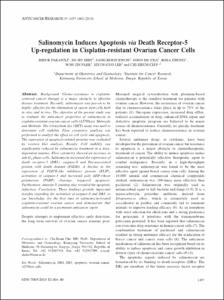KUMEL Repository
1. Journal Papers (연구논문)
1. School of Medicine (의과대학)
Dept. of Obstetrics & Gynecology (산부인과학)
Salinomycin Induces Apoptosis via Death Receptor-5 up-regulation in Cisplatin-resistant Ovarian Cancer Cells
- Alternative Author(s)
- Shin, So Jin; Kwon, Sang Hoon; Cha, Soon Do; Cho, Chi Heum
- Journal Title
- Anticancer Research
- ISSN
- 0250-7005
- Issued Date
- 2013
- Abstract
- Background: Chemo-resistance to cisplatin-centered cancer therapy is a major obstacle to effective disease treatment. Recently, salinomycin was proven to be highly-effective for the elimination of cancer stem cells both in vitro and in vivo. The objective of the present study was to evaluate the anticancer properties of salinomycin in cisplatin-resistant ovarian cancer cells (A2780cis). Materials and Methods: The tetrazolium dye (MTT) assay was used to determine cell viability. Flow cytometric analysis was performed to analyze the effect on cell cycle and apoptosis. The expression of apoptosis-related proteins was evaluated by western blot analysis. Results: Cell viability was significantly reduced by salinomycin treatment in a dose-dependent manner. Flow cytometry showed an increase in sub-G1 phase cells. Salinomycin increased the expression of death receptor-5 (DR5), caspase-8 and Fas-associated protein with death domain (FADD). A decline in the expression of FLICE-like inhibitory protein (FLIP), activation of caspase-3 and increased poly ADP-ribose polymerase (PARP) cleavage, triggered apoptosis. Furthermore, annexin-V staining also revealed the apoptotic induction. Conclusion: These findings provide important insights regarding the activation of caspase-8 and DR5, to our knowledge, for the first time in salinomycin-treated cisplatin-resistant ovarian cancer and demonstrate that salinomycin could be a prominent anticancer agent.
- Publisher
- School of Medicine
- Citation
- BIDUR PARAJULI et al. (2013). Salinomycin Induces Apoptosis via Death Receptor-5 up-regulation in Cisplatin-resistant Ovarian Cancer Cells. Anticancer Research, 33(4), 1457–1462.
- Type
- Article
- ISSN
- 0250-7005
- 파일 목록
-
-
Download
 oak-aaa-00359.pdf
기타 데이터 / 221.03 kB / Adobe PDF
oak-aaa-00359.pdf
기타 데이터 / 221.03 kB / Adobe PDF
-
Items in Repository are protected by copyright, with all rights reserved, unless otherwise indicated.